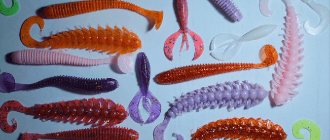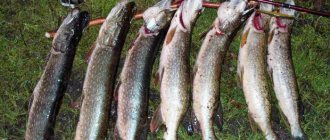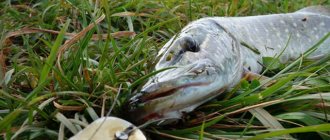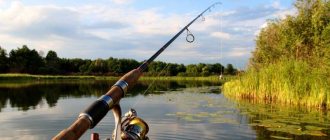Catching baits are one of the foundations for successful and efficient fishing. After all, the goal of every trip to a reservoir is a trophy worthy in size and strength of resistance. Pike is just such a desirable object of hunting, which can please with its size, and its tenacity when fishing should be given due credit, since in any situation it fights to the last, keeping the fisherman in suspense.
Pike baits are varied in their type and operating principle, and their use requires knowledge in what conditions a particular type will have the greatest attractiveness and effect when catching a predator. The article presented to the reader will help to understand this not so simple issue, which will give an idea about the main and most used types of baits for catching toothy predators.
Spoons
The most common and popular fishing bait for pike is a spoon. This is a universal type of hunting tool that consistently works against this type of predator, regardless of the hunting season. In the process of practicing lure fishing, anglers invented a number of modifications, which over time became separate and completely different types of lures in terms of operating principles. But in general, the technology of lure fishing is not particularly difficult and can be done even by a novice fisherman. To guide spinners, spinning rods are used, the performance characteristics of which depend on the weight of the fishing tool. The principles of operation of various types of spinners and the features of their structure will be discussed in the continuation of our article.
Spinners
The principle of operation of the turntable is based on the rotation of the petal around the main rod of the product, which is created by water pressure as a result of horizontal wiring. A cylindrical sinker and the working body itself – the petal – are strung on the rod. Some modifications of the turntable use two petals. The rod itself is equipped with winding rings on the front and back. The rings are designed for mounting a tee and direct attachment to the cord.
Important! Attachment to the cord must be done through a swivel, which prevents the material from twisting.
The predator is attracted to the pinwheel not only by the visual effects of the petal flashing, but also by the creation of strong vibration waves from its rotation. The petals and sinkers are painted in various eye-catching contrasting colors. The sizes and shapes of the petals themselves vary over a wide range, just like the shipping weight. Depending on these parameters, turntables have size numbers from 00 to 5, according to which the angler selects the appropriate nozzle sizes for the fishing conditions.
Oscillating spoons

The spoon is a classic and traditional pike lure. It is distinguished by the simplicity of its design and the possibilities of independent, sweeping play that attracts predators in any season of the year. The product consists of a massive petal with curves in its shape that determine the manner of play of the spinner. The petal itself has a fastening element for connecting to the tackle cord, and it is also equipped with a tee. The petals are made of metal and painted in pike-perspective colors, the most common of which is a dull silver tone. As a rule, the masses of pike oscillations vary in the range of 15–40 grams, and the length of the petal is 8–12 cm.
Non-snagging spinners

In fishing areas where high-quality and comfortable fishing is hampered by frequent snags, non-snagging spinners are used. Such fishing tools include oscillating and rotating spoons, modified with special devices that prevent bait hooks from catching on aquatic vegetation, branches of sunken trees and submerged cramps. The anti-hook device consists of a rigid wire secured in such a way as to cover the tip of the hook. The attachment point of the protective element can be located either on the petal of the spinners (in the fishing environment the device is called a mustache), or directly on the tee itself, which is most often found in the designs of non-hooking spinners. When a pike bites, the wire bends under the load of the jaws and the tip of the hook easily digs into the mouth of the pecked fish.
Castmaster
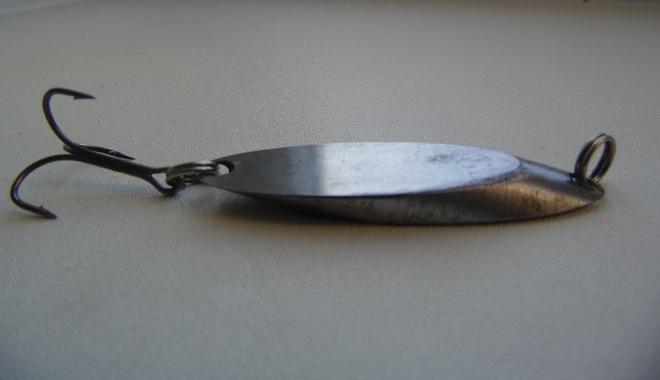
Castmaster is a special type of oscillating spoon, which is an oblique cut of a steel rod with holes in its tops into which a winding ring for a fastener and a tee is attached. The body of the spinner has no irregularities, as a result of which the play of this tool is sharp and active even with even strokes. Such a spinner is convenient to work at depth and make long casts with relatively small dimensions of the product. For pike, castmaster is zoned with red and silver paint, sometimes adding a distinct red or scarlet synthetic thread to the tees. Adding to the attractiveness of the castmaster are the holographic stickers that shimmer when the light hits them, which can be glued to both flat sides of the spinner.
Spinnerbait

A suitable bait for catching pike in the grass is a spinnerbait. This is a combined type of attachment consisting of a rigid wire frame in the form of a rocker arm. A jig head with a silicone bait with fluffy plumage is mounted on its short arm, covering a powerful single hook and at the same time preventing all kinds of underwater hooks. Metal petals are mounted on the long arm of the rocker, one of which rotates freely on a rigid axis when moving the non-hook, and the second operates on the principle of an oscillating spoon.
A massive and bright product, even in a heavily grassed water area, arouses the genuine interest of a predator and rarely remains unattacked if it is carried out not far from the place of a pike ambush. Sometimes a long silicone worm is additionally attached to the hook to make the spinnerbait even more attractive.
Fishing for pike in shallow water overgrown with grass
The situation, on the one hand, echoes the previous option, and on the other, requires completely different baits. As a rule, all those places and reservoirs that fit under the first section “Clean Water”, by the middle or second half of summer, gradually turn into a kind of swamp, only with windows of clean grass. The main difference here is the impossibility of casting a bait with open hooks, or at least it is impossible to cast it over the entire casting distance. On its way, algae constantly appears, rising to the very surface. And oddly enough, one of the most important factors in choosing bait in such places is the type of algae. Or rather, the presence and absence of filamentous algae. In general, “thread” is the worst thing that can await you in such places. If you saw it among other vegetation at the fishing site, don’t expect simple fishing. The main difficulty is that filamentous algae have the unique ability to envelop almost all types of bait. After which the bait stops working properly, and the pike loses interest in it.
>
But I propose to start with the option without this “pernicious infection”. So, in front of you is shallow water, overgrown with pondweed, or hornwort, or water lilies, or, as often happens, all of these combined...
For active search in such places where pike are located, two types of baits are best suited: non-snagging spoons with a single hook and floating gliders. There are quite enough such vibrators on the shelves of our Russian stores. But they all have one significant drawback - as a rule, they are made of fairly thick metal, which is good for quickly finding pike, where the speed of the retrieve is important, and bad for fishing when you need to slow down. And due to excess weight, they all sink very quickly during the pause. Often the sinking speed is quite high, and the pike (during periods of low activity) refuses to attack. In this case, a “secret weapon” is used - a spinner made “according to the recipe” of one very famous spinning player and athlete Maxim Dydykin. The body of the vibrator is a petal from a Mepps Aglia long turntable No. 4, to which a large single hook is soldered. If we compare it with most of its analogues entering the Russian market, it turns out that the homemade product is approximately two times lighter (8 versus 14–17 g), which ensures slow, sweeping vibrations during pauses. Such a spoon allows you to very slowly fish the places where the pike is supposed to stay.
Using wobblers for pike
Pike lures in a modern interpretation are, of course, wobblers. A huge set of artificial imitators, differing in performance characteristics, the shape of their body and the method of its assembly, color design and wiring principle. Of the main types of wobblers for pike, it is worth noting the following:
- minnow - with a slender and long body;
- fat - thick and voluminous body shape of a wobbler;
- shad - tall wobblers flattened on the sides;
- crank - with a wide and flat wobbler body, having factory settings, its own game.
In addition to the variety of shapes, it is worth noting such quality of wobblers as the buoyancy coefficient, which has three main degrees:
- floating wobblers;
- sinking wobblers;
- wobblers with neutral buoyancy or suspenders.
All of these types of artificial baits are suitable for successful pike fishing, but in the future we will focus on the two most interesting species, fishing for which is both spectacular and at the same time quite effective during the summer season.
Popper
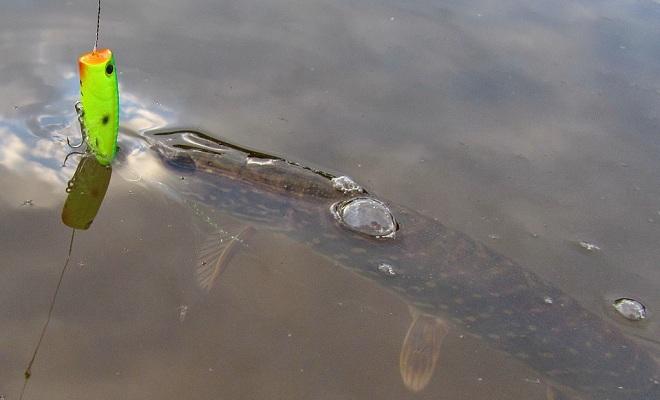
Popper is a surface bait for catching pike. This type of fishing tool is a floating wobbler, which does not have a working blade. The vane replaces the cut or funnel-shaped depression at the front of the popper. The operating principle of the popper is based on its stepwise movement along the surface of the water through dotted pulls with a spinning rod, which results in gurgling sounds with splashing water, arousing the interest of an active predator. To make it attractive, metal balls can be built into the body of the popper, creating a noise effect when inserted.
Croatian egg
Another creative surface lure for pike is the Croatian egg. This catching tool is made of plastic or wood in the shape of an egg. The product has positive buoyancy. A single hook is built into the rear end of the form, and there is a fastening eyelet at the front of the nozzle. The Croatian egg is balanced in such a way that the tip of the hook, when the bait is in the water, is always turned upward and is above the water. Consequently, a Croatian egg carried along the surface of a reservoir never clings to dense aquatic vegetation, allowing it to comfortably hunt for pike standing in shallow water in toad grasses and ponds heavily overgrown with algae.

The body of the non-hooking fish is painted in various colors and tones, the variant of which is used based on the intensity of illumination of the reservoir at the time of fishing.
Jig head for pike: which one is better
The jig head is one of the key components of equipment in jig fishing. It is a sinker connected to a hook and with an attached silicone bait.
Shape, how many grams
When choosing a jig head, special attention should be paid to how much the head weighs and what shape it has. Weight depends on conditions of use. The ideal weight is when the bait, lifted from the bottom, appears on the bottom again after 3-4 seconds when using a step retrieve. The more the current increases and the deeper the fishing spot, the heavier the jig head needs to be used. Another parameter that influences the choice of jig weight will be the size of the bait.
The ratio of bait size and cargo weight:
- if you use a bait up to 8 cm long, then a sinker weight of up to 10 grams is best;
- with a bait size of 8 -10 cm, the jig head is suitable weighing up to 21 grams;
- For bait up to 13 cm in size, it is best to use a weight of up to 24 grams.
Photo: Types of jig heads
There are several forms of jig heads:
- Globular. The most popular type. Can be used on any body of water and regardless of fishing conditions. The disadvantage of this type is that it falls on its side at the bottom and the fish cannot be caught well.
- Fish head. This type has the longest range. It clings to snags and grass less than other species due to its tapering shape towards the front edge.
- In the form of an iron. This bait has a platform with which the head rests on the bottom and the hook is raised, which increases the chances of a bite.
- Rugby. When using this type, the position of the hook is always with the tip facing up. Being at the bottom does not collapse, unlike a ball. Minus - it is not suitable for use on a rocky bottom, since due to its shape the sinker clings and gets stuck at the bottom.
About
Silicone jig baits for pike
With the invention of such an innovative material as silicone, it became possible to produce imitators that are quite similar to natural predator food items. In addition to the realistic transmission of the movements of a living object and the similarity of shapes, it is worth noting the fact that silicone and rubber baits are inexpensive, and this only adds to the popularity of this type of bait. Among spinning rods, the most famous types of silicone are vibrotails and twisters.
All kinds of slugs in the form of crustaceans and worms are less popular in pike fishing, but in some conditions, combined with the specificity of the equipment, their use also brings tangible results in terms of catches. Recently, so-called edible silicone has become increasingly popular. The composition of this kind of simulators includes attractants, additionally, by smell, which attract the predator to the fishing zone during fishing. Silicones have a wide range of colors, as well as a huge range of standard sizes.
Vibrotails
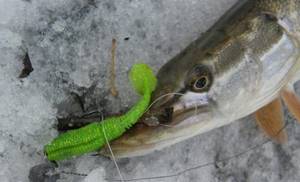
Silicone in the form of a vibrating tail is an imitation of a small oblong fish with a short, hoof-shaped, movable tail. This type of bait is used in combination with jig heads of various types. In some types of spaced equipment, for example, a retractable leash, a vibrating tail is used without weights, only equipping the product with a hook. On sale you can find vibrotails of different shades, but spinning rods for pike fishing recommend more restrained natural colors, using catchy and bright colors only during the summer season for passive biting. In the hunt for trophy pike, vibrating tails with sizes starting from 20 cm are used, mounted on equipment specially designed for heavy silicone, consisting of a tandem of doubles.
Twisters
The twister, according to the principle of its use in pike fishing, is quite similar to the use of a vibrotail. These silicones only have differences in their shapes. The twister has a cylindrical body shape with a long and wide sickle-like tail. The body can be smooth, or it can have corrugations, which accompany the wiring with a peculiar sound effect that intrigues the pike. The pike twister is distinguished by its size, which is at least 10 cm and often contains attractants in the silicone material. The active play of the twister tail with various types of fishing in combination with round jig heads makes fishing successful with this type of simulator throughout the entire period of open water.
Worms
Silicone worms are one of the types of slugs that can be effectively used to catch toothy predators. The shape of this type of silicone resembles a large earthworm or leech. The length of a bait in the form of a worm capable of seducing a pike can reach 15 cm. The worms are included in movable rigs with a weight in the form of a Cheburashka, or they are stuck on large single hooks in the middle of the body and dragged along the bottom, lifted with short jerks.
Silicone lures for pike fishing
This type of bait brought about a revolution and brought recreational fishing to a completely different level. The use of soft material made it possible to make the bait play more realistic, which resulted in a large number of bites.

In addition, silicone baits break all records in terms of their variety: vibrotails, twisters, leeches, worms, cuttlefish, mice, toads, crustaceans, etc. All of them, in the hands of an experienced spinning fisherman, turn into baits that very plausibly imitate living creatures, and this does not leave without the attention of a predator. The wiring technique can be the same as for “spinners” and “oscillators”, but when using “silicone” spinning rods, spinners use stepped wiring.
You can learn about wiring techniques on the Internet by watching the corresponding video. And yet, sometimes you have to experimentally find the wiring for a particular bait. Fishing is a boundless field for experimentation, where you can find and lose, meet success or failure.
Foam rubber fish
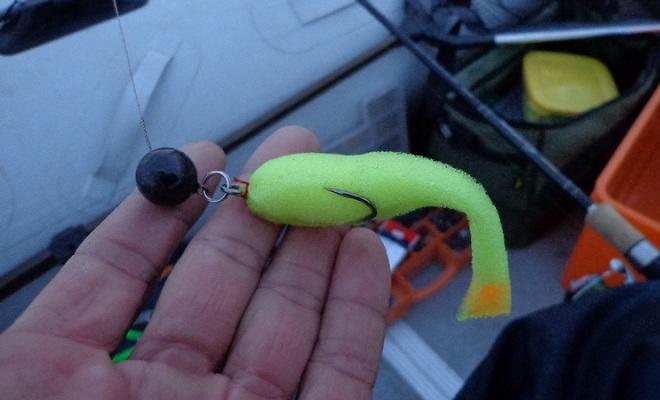
Another type of soft bait is a foam fish. An imitation in the form of a fry or an oblong cone, a carrot, is cut out of dense foam rubber and painted in colors that suit the season or depending on the shade of the water. Loading, as in the case of classic silicones, is carried out using a stationary jig head or using a Cheburashka. Wiring of foam rubber is most often done using the technique of jig, twitching and uniform winding of the cord. Pike prefers large foam rubber fish, which are at least 80 mm in length.
Tackle for pike fishing with spinning rod and bait according to the seasons
Depending on the season of the year, the behavior of the predator changes, the degree of its feeding activity either increases or decreases. In connection with these features, the equipment of a spinning rod for pike fishing is undergoing changes, expressed in the adjustment of rigs to the bait used. So that a novice spinning angler can fine-tune his tackle in the right direction, we will consider the annual fishing cycle in the context of using the most promising baits for the season.
Spring
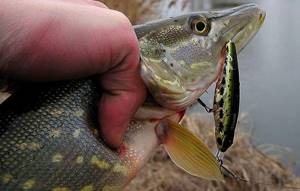
Spring time is characterized by a surge in the activity of pike in the pre-spawning period, a time of no-biting during the spawning itself, a post-spawning glutton and the transition of the fish to a sedentary lifestyle with insignificant feeding activity. Spring is characterized by the use of small-sized baits with intense play in fishing. Crank-type wobblers and spinners fit these definitions. The distinctness of the play of these instruments provides the prerequisites for the use of nylon cords in equipment.
Summer
In the summer, the toothy one becomes capricious. The abundance of natural food available to the fish forces the fisherman to look for bait that most closely imitates the behavior of the fry. The rod's fast action coupled with thin braided line allows for the highly controlled animation required for minnows and topwater poppers. The use of this type of simulators in the summer season is a priority.
Autumn
The protracted period of the predator's autumn feeding period makes it possible to reduce the requirements for the quality of animation of baits. To increase the reliability of the equipment, you can use a medium-action rod without increasing the diameter of the braided cords. The sizes of baits are increased in the hope of catching large specimens of the trophy. Pike fishing gear in the fall may be coarser compared to equipment at other times. In the autumn, silicone baits, spinners and wobblers of various types are used.
Natural baits for pike
The best baits in terms of their attractiveness to predators are, of course, live fry. But their use is not always convenient. Live fry are used for fishing with float live bait rods, bottom rigs, circles, winter flags and girders. In spinning fishing, dead live bait is used, placing it in a special equipment. Pike loves small crucian carp, roach, and gudgeon as bait. In reservoirs where perch and ruffe live, these types of fish also pass for live bait. The toothy fish will not disdain loaches and spined loaches mounted on bottoms for pike perch and catfish, and small bee-eaters can serve as good bait for large pike.
What size bait is best
The size of your bait should match the size of the pike you want to catch. If you fish in shallow water where there are a lot of weeds, you will most likely only be able to catch smaller pike. The time of year and time of day must be taken into account.
Fishing for pike is a very pleasant and rewarding activity, but if you take the wrong type of bait, the fishing may not take place. In the spring, pike usually stay close to shore before moving further out during the year. They don't feed at night, so the best times to fish are sunrise and sunset, although you can try throughout the day. Pike can also be aggressive with sharp teeth, so it's worth getting a strong fishing line.
Views: 336
Similar articles:
- Leashes for pike: types of leashes, optimal length, determining which ones are better Pike is a desired trophy for any angler. Someone purposefully...
- Pike fishing in October: where to look, what gear to use, pike habits Pike is the real queen of domestic reservoirs. Autumn is coming, and with...
- Pike bait color. What are the favorite colors of the toothy predator? Disputes over the choice of color scheme for pike lures or...
- Fly fishing. Fly fishing equipment and fishing techniques It is believed that fly fishing for pike is to some extent a special type...
Frog

In toad grasses and overgrown ponds with a large frog population, this type of bait, especially when hunting pike in the summer, becomes a promising direction when equipping live baits and bottom gear. For the bait, select small-sized frogs, green or brown in color, and place them in the rig, piercing the thigh with a single or double hook. This manipulation is done in such a way that the amphibian can move freely.
Important! When selecting a bait, the main thing is not to confuse baby frogs with toads, but distinguish them by their bumpy and warty skin.
The toad is not a food item for pike and the angler will definitely not get a bite on such a bait in any case.
Balancers
Balancers are a type of horizontal spoon that belongs to the section of winter baits. The balancer is made of lead with soldered single hooks in the front and tail. There are fastening loops under the belly and on the back of the fish. The lower loop is for mounting a tee, and the upper loop is for connecting to the fishing line of a winter fishing rod. A distinctive feature of balancers is the presence of special balancing wings in the tail unit, which determine the playing pattern of the instrument. The game itself resembles the scouring movements of a disoriented fry. Pike balancer sizes are considered to be products over 60 mm, and the most promising color ranges are perch colors.
Rating of the 10 best lures for pike
In this section of the article, we will combine the best lures for pike into a single list, presented in the form of a rating, on the basis of which the angler can create a set of effective and, most importantly, catchy pike tools that can provide a positive hunting result in various pike fishing conditions.

- Our top 10 will open with a versatile and quite catchy example of a classic pike bait, the Mepps Syclops . It is with this variety of spinner that we recommend starting the formation of your pike arsenal and toothfish fishing itself, visiting any body of water for these purposes.
- We give the second position to the same Mepps brand, only with a turntable model Aglia Long . This option can entice even the most passive fish to bite and thereby make fishing productive.
- The third line is behind the Megabass Vision OneTen . The twitching model of the minnow type in various types of colors covers a variety of fishing conditions in shallow waters, where the probability of finding active pike is highest.
- Fourth place goes to the silicone vibrating tail Mann's Predator . Jigging with such a tool works especially effectively in the autumn season and provides the opportunity to fish in different depths of the reservoir.
- Five for Yo-Zuri 3D Popper . This is an indispensable option for fishing in overgrown reservoirs during the summer season. The high quality of the product and the seductive style of movement lures even the most cautious predator to attack.
- to the Castmaster spinner . The spinner receives such a high rating for its range and versatility of fishing horizons, which puts the spinner in the category of universal fishing tools.
- The seventh number is awarded to the balancer. After all, winter ice fishing is no less successful than summer pike hunting, and balancers from the Lucky John with the Classic line of models will only contribute to a positive result.
- Position eight behind the Zipbaits orbit 110 SP . The wobbler does an excellent job of catching trophy fish. In addition, the simulator has high quality hooks and a paint coating that is quite resistant to pike teeth.
- In ninth place we present the twister Megabass Counter Grub . Edible silicone is applicable in any period of open water and with the right point of delivery; its play rarely remains deprived of the attention of the catfish.
- Our top list of the best lures for catching pike closes with a non-hooking hook in the form of a Croatian egg Bumble lure J7-x . Its presence in the arsenal will completely relieve the pike fisher from the problems of catching overgrown, but promising reservoirs for pike, making fishing both comfortable and productive for trophies of various sizes.
Shallow-water minnow wobblers for pike
At summer depths of about 1 meter, standard 110-130 large minnows will not pass on pike. But some of the main pike kit with tension can be used at such depths - Zip Baits Orbit 110, Strike Pro Inquisitor 110SP. With skillful retrieval, these baits, designed for somewhat greater depths, can be cast on soft twitching with long pauses in the horizon no more than a meter from the surface. If you pull hard or wind the reel quickly, the wobbler will go lower and catch the grass, snags or bottom over which you need to pass the bait.
At the same time, when specifically hunting for pike, the best wobblers for pike are large twitching minnows. They mow down any pike, both large and grassy ones. The toothy one grabs these baits not for food, but to ward off an insolent competitor who has invaded the predator’s ambush. Many anglers, without diving deep into wobblers, often fish with small baits, using regular baits or pulling with pauses.
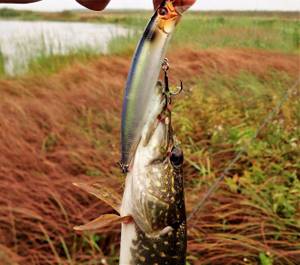
Therefore, they deprive themselves of the maximum possible hunting satisfaction. Because pike and wobblers are primarily twitching, and the rest is additional capabilities and tools, including in shallow waters. And twitching for pike is primarily large minnows in sizes 110, 130 mm and more. More about twitching wobblers
The base for a set of wobblers in shallow water for pike are large baits with a depth of about a meter, as well as large subsurface baits. These are both variants of well-known pike killers in a special surface design, as well as special shallow-water baits. There are many specific models of wobblers that work well for pike. Here are examples of the most popular and catchable ones, which have proven themselves among many anglers.
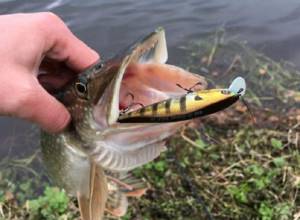
Vision Oneten 110 HF
In addition to the already noted 110 Orbit, Inquisitor and the like, at depths of about a meter, a special surface version of the vanten from Megabass, the Vision Oneten 110 HF, completely copes with its tasks. The HF prefix stands for fast-floating. It is difficult to drive a shallow-water vantan to a depth of more than a meter. Therefore, it can be safely used over grass, bottom or snags, where there is clear 1-1.5 meters of water.
This catchy surface wobbler for pike naturally has all the characteristics of the mega-bass line. Due to the rapid ascent, they are more comfortable working in shallow waters than in orbit - there is no need to be afraid of the possibility of accidentally getting caught. We drove it deep, on the verge of a snag - we waited a little, then we moved on. Weight – 14 grams, length – 11 cm – like all 110 Vanten. However, the depth is 0.7-0.9 meters. It works both on hard twitching and soft twitching; sometimes pike take this bait on even baits with pauses or Stop-and-Go pulls.
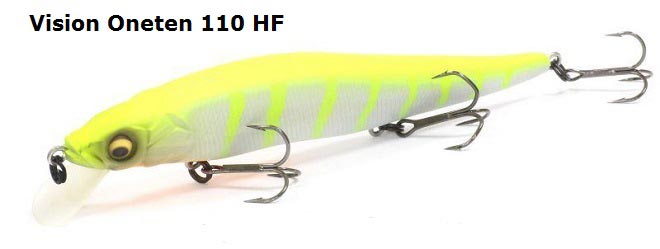
Balisong 100F
Another borderline wobbler for shallow water for pike and perch, if we consider a depth of about a meter, Deps Balisong Minnow 100F. All other versions of the balisong are deeper, but this one is floating, with a depth of 0.8-1 m, with weak twitching - a little more than half a meter. With a length of 10 cm, it weighs 14 grams. There are no difficulties with wiring the balisong - the wobbler responds to any twitching options, jerking and pulling.

Basara 90F
The Lucky John Basara 90F wobbler in the floating surface version works well on aggressive twitching on active pike, and on smooth jerks with pulls on passive pike. 9 cm and 10 gr. weight, goes a little more than half a meter deep.
There are many medium minnow models operating within this depth boundary. However, if the target is a large pike, you are more likely to catch it using larger wobblers.
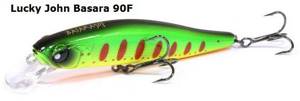
Selection of baits depending on the season and conditions
There is no universal and most catchy bait for pike. The success of using one or another type of bait also depends on the season of the year, which is associated with changes in the behavior of the predator. In continuation of our material, we will consider the success of using various types of bait for pike based on this criterion in order to justify the relevance of choosing an effective fishing tool for the season.
Pike baits in spring
The spring period is characterized by high predator activity, but fishing difficulties arise due to muddy water. For these conditions, the color of the bait should be as bright as possible, and the presence of devices that cause noise effects in the designs of fishing tools is also welcome. The best results are obtained by using rotating spinners and wobblers. At depths, in terms of prospects, silicone baits on jig heads occupy a leading position. As the water warms up and vegetation in reservoirs increases, they switch to the use of surface baits, poppers and lightly weighted spinnerbaits.
Summer
The summer period is not particularly famous for catching toothfish. The fish is inactive and picky when choosing bait. It stays in certain places, hunting from ambush, waiting for passing prey. The greatest success during this period of the year is fishing for pike with surface baits. Croatian eggs, poppers, as well as spinners and spinners with aggressive bright colors are the first to be used. The predator in warm water does not like fast movements, preferring to attack victims at low speed, without spending much energy on the throw. It is worth noting that fishing with live bait is promising in windows of dense vegetation using live bait of the type of fish that predominates in the diet of pike in the fished reservoir. According to the principle of this type of fishing, a live frog can also be used.

Autumn
Autumn is considered a purely pike season. Now the predator hunts not only on the surface of shallow waters, but also prowls in search of prey throughout the entire water area of the reservoir, patrolling, including deep-sea areas, and coastal zones near the walls of vegetation. Fattening to gain calories for the winter season, the fish actively takes any type of bait, the size of which can reach 2/3 of its own size. Wobblers, spinners and large silicone are used.
Important! In clear water, preference is given to natural colors, trying to use soft tones, without much shine, sometimes on the contrary, alarming the fish.
With cold weather, pike move to greater depths and stay on the slopes in the pits. Now there are prospects for fishing at fast and moderate speeds that cause aggressiveness in active fish. In the fall, they continue to fish with live bait, using it on bottoms and live bait float rigs. Dead fish with a high probability of being bitten are used for spinning castings.
Winter
Winter varies in the intensity of fish activity. Pike bite well on first ice and with the arrival of the first serious thaws on the eve of spring, indicating the imminent period of its spawning. A low level of bite is observed in the dead of winter, when frosts are severe and the ice is covered with a thick layer of snow. At this time, the predator stands in the deep parts of the reservoir, and you can catch it using balance beams and vertical spoons. Ratlin-type wobblers are becoming increasingly popular in ice fishing for pike. But still, the most successful is ice fishing using live bait. They catch with live bait using winter girders, stakes or flags. The classic type of live bait is considered to be small crucian carp, but if you have a freshly caught roach or bass, you should change the bait to this type of fish, which is more mobile in cold water. Roach and perch are more active in winter than heat-loving crucian carp, and therefore are more attractive to the fish that hunt them.
Rating of baits by type
Fifth place
You can give it to spinners.
- Mepps “ Aglia Long ” With a silver petal of the 1st and 5th category. It is very effective in fast currents, starts well, and is capable of working in very slow retrieves. It has a narrow and long blade, which allows you to make a good cast.
- Mepps " comet Black Fury " Has a bright color that can provoke a predator such as pike. It is universal and can be used both in current and still water. Provokes the predator to attack in any weather conditions. A very catchy bait.
- Daiwa “ Spinner - R ” Resembles the shape of a fish, and is suitable for all types of fishing and for any water. Unique in that it can be cast far, unlike other spinners.
Fourth place
They are occupied by poppers, which are not replaceable in the heat.
- Yo - Zuri “3 D Popper ” A Japanese product that perfectly combines quality and price. The bait is brightly colored and easy to use. You can successfully catch both pike and perch with it.
- Kosadaka “ Next ” This popper looks like a fish with an open mouth. When retrieving, it makes loud sounds that travel well in the water, attracting a predator.
- Silver Stream “ Pike - S ” This is a bait designed for “hunting” large predators. “Pike-S” has unique hydrodynamics: when immersed in water, it takes on an almost vertical position and only the spout peeks out a little. Experienced spinners use it to imitate the movements of many animals caught in the water, which is decisive in its catchability.
Third place
The golden mean is occupied by oscillating spoons, which for many years have served and are serving “faithfully” to anglers.
- Acme - “ Kastmaster ” A unique bait that can fly very far and seduce any predator, including pike. Many anglers use it to catch asp. It is very pleasant in appearance, but has nothing superfluous, and precise technology allows it to play believably in the water.
- Mepps " Syclops " Has a complex shape with ten sides that reflect the sun's rays. It believably imitates the movement of a fish, and therefore always provokes a predator to attack.
- Rapala “ MinnowSpoon ” It is a “non-hooking” bait that imitates the movement of a fry. A unique bait, since with its help you can fish in dense water thickets, where pike are usually found waiting for their prey, and snags, to which pike are also not indifferent.
Second place
Silicone baits are rightfully occupied, without which anglers cannot imagine fishing. Silicone baits are mainly designed for jigging or micro-jigging, depending on the size of the bait and the weight of the jig head. It should be remembered that for jig fishing, the fisherman must have at least two types of fishing rods: soft, for micro-jigging, and hard, for jigging. It is very important that the rod test matches the type of bait you are using. Such catchy baits include:
- Bait Breath “ RushCraw ” Creates chaotic movements in the water, provoking a predator to attack. It is especially effective during periods when the pike behaves passively and does not respond to bait offered to it.
- Rains " GTailSaturn " May be irreplaceable in an angler's arsenal. This silicone bait has the appearance of a worm with a twister tail and can play even with the slowest retrieve.
- CrazyFish “ VibroFAT ” This is a silicone bait with special slots that allow you to use an offset hook. With an offset hook, this vibrating tail turns into a non-hooking one and allows the spinning angler to fish in feeding areas.
Most of these baits are made from edible silicone, which further attracts predators. Edible silicone is increasingly invading the life of the amateur fisherman, making fishing more interesting and effective, although such baits are more expensive than baits made from ordinary silicone. As they say: “You have to pay for everything,” and for pleasure too.
First place
By right, you can give it to minou class wobblers.
- ZipBaits " Orbit " Has increased weight, which allows you to throw the bait a little further than other baits in this class. It may be that its great massiveness attracts pike.
- JackallTinyMagallon Allows you to catch pike under different fishing conditions. It plays stably and beautifully with all types of fishing, both in current and in still water.
- Rudra O. _ S. _ P. _ Reliably leads in catchability among the presented specimens. It flies well, and when moving it creates powerful sound vibrations that provoke a predator.
This list is far from complete and can be added to by any spinning player if desired. To do this, you just need to purchase several baits you like and experimentally determine in a pond which one the pike likes best. When choosing lures for pike, greater preference should be given to branded lures, but not to their cheap copies. They may differ in play, as they are produced with technological violations: it may not be the same material, and the coloring may be somewhat dull than the original.

